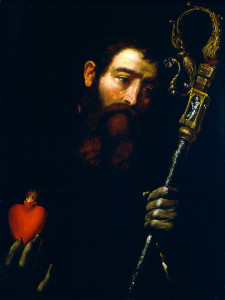St. Augustine
Oil on panel
Gaspar de Crayer
Flemish, 1584–1669
Click on the links throughout the article to view additional artists’ works and reference material.
Gaspar de Crayer began his career in the city of his birth, Antwerp. He later moved to Brussels and trained under the artist Raphael Coxie, court painter to Archduke and Duchess Albert and Isabella. This introduction to the court facilitated a longstanding relationship with the rulers of the Spanish Netherlands. De Crayer eventually did work himself for the Archduke and Duchess and went on to receive the appointment of official court painter to Cardinal-infant Ferdinand and eventually well-known art collector, Archduke Leopold Wilhelm. He embraced life in Brussels serving as dean of the Brussels painters’ guild from 1611–1616 and as a member of the city council from 1626–1627. In his later years, he moved to Ghent where he died.
De Crayer spent much of his career fulfilling commissions for altarpieces, however, he also dabbled in portraiture as well. His works show similarities in style and technique to those of Peter Paul Rubens and Rubens’ famous student, Anthony van Dyck (both of whom are represented in M&G’s collection). Today, de Crayer’s works fill world-renown museums such as The Metropolitan Museum of Art, the Museo del Prado in Spain, the Kunsthistorisches Museum in Vienna, and the Musée des Beaux-Arts in Paris. The presence of Gaspar de Crayer’s St. Augustine at the Museum & Gallery reveals the breadth and importance of the Old Master collection.
De Crayer’s St. Augustine illustrates the depth of religious fervor Augustine possessed. The flaming heart, depicted here in Augustine’s hand, symbolizes his zeal and devotion for God. The contrast of the dark background draws the viewer’s attention to Augustine’s face where he appears lost in thought. This small dramatic painting was most likely meant for private devotion and to inspire the viewer to the same religious ardor that ruled Augustine’s life.
Known as one of the four eminent Fathers of the Western Church, Augustine of Hippo remains one of the most well-known figures in church history and Christianity. Augustine was born in a province of North Africa in 354 CE where he received an excellent education and excelled in rhetoric and philosophy. His studies exposed him to a wide array of religions and philosophies leading him to live his early years in moral irresponsibility. His mother, Saint Monica, devoutly prayed for her wayward son and saw the answer to her prayers in the form of Saint Ambrose of Milan. Under the teaching and guidance of Ambrose, Augustine converted to Christianity becoming a priest and eventually a bishop. He is perhaps most well-known for his writings, Confessions (an autobiography) and The City of God as well as his fervent zeal for the spread of Christianity. In art, artists typically portray Augustine in the vestments of a bishop as evidenced in this work by the presence of the crozier (bishop’s staff carried by high-ranking church officials).
Rebekah Cobb, Guest Relations Manager
Published in 2016

